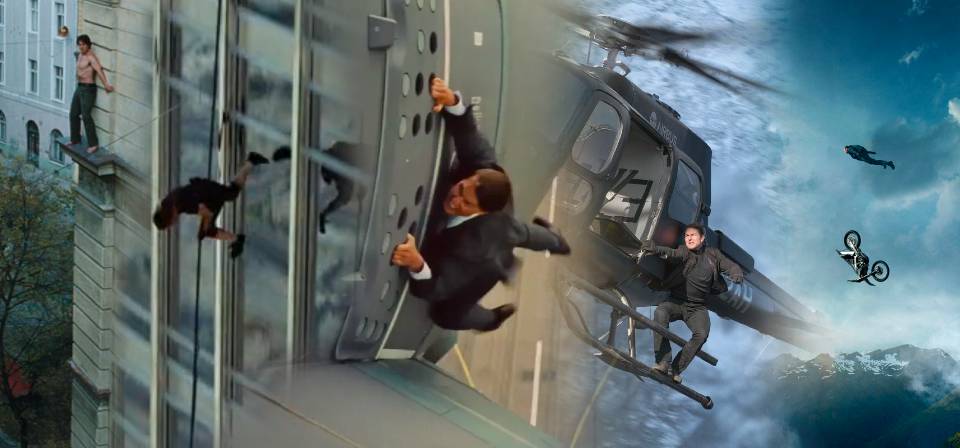If there’s a “before” and “after” in the “Mission: Impossible” franchise, an obvious dividing point is the Burj Khalifa. This now-iconic sequence in the fourth film, 2011’s “Mission: Impossible – Ghost Protocol,” revolutionized the series around spectacular set pieces centered on Cruise actually performing jaw-dropping, death-defying practical stunts on location. By contrast, in 2006’s “Mission: Impossible III,” when Ethan Hunt needed to access the roof of a heavily guarded Shanghai skyscraper, while Cruise really did the swing and the wirework the stunt called for, he did it on a stage with green screens, not in the steel and glass canyons of Shanghai. What set the bar for the future was going to Dubai and climbing on the face of the world’s tallest building; every subsequent big set piece, from clinging for dear life to the fuselage of an ascending turboprop military aircraft to riding a motorcycle over the edge of a cliff, has sought to clear or even raise that bar.
However, there’s an even more crucial before-and-after moment in “Ghost Protocol,” some 20-odd minutes before the Burj Khalifa sequence. It’s not as flashy, certainly, but in a way, it’s just as momentous. The scene finds Ethan on a fourth-story ledge of a hospital building in Moscow, looking down into a roll-off dumpster. It was here that I first realized that I was seeing something new—something that would ultimately mark the beginning of Ethan Hunt’s second act and of Tom Cruise’s third.

The first three “Mission: Impossible” movies all have memorable set pieces and images, above all, the iconic CIA vault sequence in the inaugural 1996 Brian De Palma film: a nail-biting tour de force of tonal and literal suspense. They also have significant drawbacks, varying as much as the styles of their very different directors—but one limitation common to them all. In the early films, we see Ethan leap from an exploding helicopter to a bullet train in a tunnel, jump from one face of a red sandstone tower to another while free soloing, and yo-yo over the exterior wall of Vatican City. What we never see before that hospital ledge, though, is Ethan blink in the face of a death-defying challenge.
“Ghost Protocol” actually opens with another Impossible Missions Force agent, Hanaway, leaping off a rooftop and executing a series of midair maneuvers so outrageous, with such all-in-a-day’s-work panache, that, watching for the first time, I resigned myself to two hours of casually weightless cartoon superheroics. When Hanaway is murdered moments later, the sudden reversal feels like rapid-fire moves in a game of speed chess—a feeling that persists as Ethan winds up hospitalized, handcuffed, and guarded by a Russian intelligence agent named Sidorov, only to escape the cuffs using a paper clip and, Batman-like, vanish from the hospital ward within seconds. Until that is, Sidorov leans out the window and incredulously spots Ethan on a ledge, wearing only torn slacks, looking down at a dumpster dozens of feet below.
“How to Jump From a Building Into a Dumpster” is one of the extreme procedures detailed in a small 1999 volume titled The Worst-Case Scenario Survival Handbook, by Joshua Piven and David Borgenicht. The contents are based on expert input, though the book is officially classified as “humor.” It is reportedly “entirely possible to survive a high fall (five stories or more) into a Dumpster, provided it is filled with the right type of trash (cardboard boxes are best) and you land correctly.” Ethan is only on the fourth story; if anyone can land correctly, it’s obviously him. Yet who would count on a dumpster outside a hospital to contain the right type of trash? Ethan glances uneasily at Sidorov, who gestures invitingly toward the dumpster: Be my guest. Shirtless, barefoot, breathing raggedly, Ethan looks down … and, for the first time since we’ve known him, decides that he doesn’t like his chances. Defeated, he begins inching back toward Sidorov and captivity.
Then comes the electric punchline. A passing delivery van; a quick calculation—and Ethan, leaping from the building, finds a way to street level almost as preposterous as Hanaway’s. The differences, though, are crucial: Ethan is anxious and desperate, and he doesn’t quite (as they say in gymnastics) stick the landing. Throwing his belt over a power line, Ethan ziplines down to meet the delivery van—but when he lets go, he topples off the van and tumbles heavily to the cobblestones. Sidorov, fortunately, is almost as stunned as Ethan recovers, enough to scramble to his feet and dash around a corner.
What the “Mission: Impossible” series discovers at this moment is this: Imperfect stunts can be more thrilling than perfect ones. An unflappable Superman who always knows exactly what to do and does it perfectly is less exciting than a fallible, vulnerable action hero—one who can be caught by surprise, who hesitates and has misgivings, who is forced to improvise, sometimes miscalculating and even getting hurt.
Establishing that Ethan is fallible and can get hurt is part of what makes the Burj Khalifa sequence so thrilling. It’s riveting to watch him step out into empty space 123 stories up and laboriously make his way to the 130th floor; it’s even more thrilling to watch Cruise run (any time he runs, he’s just Tom Cruise) back down the side of the Burj Khalifa on a tether. The final payoff, though, comes when the tether proves too short, obliging Ethan to take a running leap, spinning free of the building and releasing the line with split-second timing, freefalling toward safety … but coming in a bit high. Bashing his face against the wall above the opening, he is saved only by the quick action of his teammates, who manage to catch him by the ankle and haul him back into the building. This would never have happened in earlier installments.
To be fair, Ethan wasn’t really an action hero in the beginning, and the CIA break-in certainly makes him sweat. Yet the first film’s climactic helicopter-train-tunnel sequence, while it gets points for audacity and ingenuity, is solidly in cartoon territory. The same is true of the mannered, balletic violence of John Woo’s stylish, divisive “Mission: Impossible II,” in which, no matter how much punishment he takes, Ethan never loses his impassive cool. By the Shanghai skyscraper sequence in “Mission: Impossible III,” there are hints of what’s to come, though we don’t see what circumstances force Ethan to improvise his base jump exit from the building or how he reacts to them.
Ethan’s second act corresponds to the third phase of Cruise’s career, though the transition from the long, successful first phase to the shorter, awkward second one is fuzzier. After two decades of almost charmed superstardom, Cruise infamously suffered a series of mostly self-inflicted PR disasters in the 2000s: Deriding psychiatry, shaming Brooke Shields for taking antidepressants, unnervingly intense proselytizing for Scientology, and of course, “jumping” on Oprah’s couch. Cruise’s public image has always been complicated, but by the mid-2000s, he was widely perceived as off-puttingly nutty. When he went to work on “Ghost Protocol,” there was talk of passing the torch to Jeremy Renner.

Instead, “Ghost Protocol” kicked off Cruise’s mission to claw his way back to the top. Going silent about his controversial opinions and personal life, he put everything he had into making the Tom Cruise narrative about his willingness to push himself to the limit and the limits of what audiences had ever seen anyone do. People thought of him as a crazy zealot; he set out to become the crazy zealot of action spectacle. He had done his own stunts for years; now, he began doing things no stuntman had ever done, things no one would ask or expect of a stuntman.
Cruise’s extreme commitment is mirrored in Ethan’s—a reality highlighted whenever Ethan takes an unexpected hit or Cruise gets really injured. Perhaps the most striking difference between first-act and second-act Ethan is this: Ethan chooses to walk away from the IMF at the end of each of the first three movies. For second-act Ethan, walking away is unthinkable, and normal, private life is a luxury he can’t afford. The De Palma film massacred Ethan’s entire team; not until the end of “Ghost Protocol” is there finally a sense of a real team around him again. “Your missions,” he tells them, adding, “Choose to accept them.” That unorthodox use of the imperative tense tells us that Ethan’s choice is made: a different choice from the one at the end of every prior film. The IMF is now his family, and impossible missions are his life.
Nor is it just Ethan or just “Mission: Impossible.” Quintessential third-act Cruise movies include “Edge of Tomorrow,” an alien-invasion movie with a “Groundhog Day”–like time-bending premise, and “Top Gun: Maverick,” establishing Pete “Maverick” Mitchell as Cruise’s other signature role with a second act. His “Edge of Tomorrow” character is a shallow, self-interested glad-hander (not unlike many first-act Cruise roles) who is gradually remade through one temporal iteration after another, progressively becoming the ultimate warrior, preternaturally gifted and willing to do whatever it takes, even dying countless times, to save the world and the one person who understands what he’s going through and what he can do. As for Maverick, while he’s not Ethan (Ethan wouldn’t have pushed the Darkstar to Mach 11 if Mach 10 were enough), he’s come to share Ethan’s driving determination to do whatever is necessary to see the mission through and to bring his team home safely, along with Ethan’s aura of singular ability as the one man who can get it done. Even Cruise’s young co-stars had to commit to boot camp and flight training for “Maverick”’s unprecedented aerial cinematography, acclimating to extreme g-forces in order to perform in rolling, spinning F/A-16s—something no one could ask or expect, except Cruise.

As triumphant as Cruise’s third act has been, there’s no going back to the kind of bankable superstardom he enjoyed for so long. Those days are gone forever, not just for Cruise but for everyone in the intellectual-property entertainment era. The new stars are brands: superheroes, video games, and toys. In Ethan’s second act, and Maverick’s, we see Cruise figuring out how to succeed in the current environment without that advantage. This is no longer just a tactic to offset bad PR. Cruise has become a quixotic standard bearer in an era marked by a lazy overreliance on digitally generated spectacle and synthetic action, as another way of making movies, for creating must-see big-screen spectacles by celebrating human potential and achievement. Ethan regularly saves the world; the box-office success of “Top Gun: Maverick,” in the words of no less than Steven Spielberg, helped to save Hollywood. But even that isn’t all. Cruise made “Ghost Protocol” in his late forties and spent his fifties making the sequels. Now 60, he recently expressed his intention to go on making “Mission: Impossible” movies into his eighties Cruise seems to want to extend his third act until the first two acts are mere prologue, to outrun time itself.
With each passing year, Cruise’s creative resistance looks as much more quixotic as it does more necessary. It’s almost eerie how “Dead Reckoning: Part One” has arrived as anxieties in Hollywood over its own future and the role of encroaching technology in that future have reached a tipping point. Among the stakes in the historic double strike of Writers Guild of America and the Screen Actors Guild are the displacement of human creative work by rapidly evolving AI. Subtext is text in “Dead Reckoning Part One,” which grapples explicitly with anxiety over superhuman technology and human obsolescence. There were lowkey concerns in “Maverick” about drones eventually replacing elite fighter pilots, but in “Dead Reckoning Part One,” the enemy has arrived. Computer-generated illusions erode access to truth and reality, and the very notions of right and wrong hang in the balance. Tom Cruise and Ethan Hunt may never give up, but what mission will be worth fighting for if human beings lose the future?











